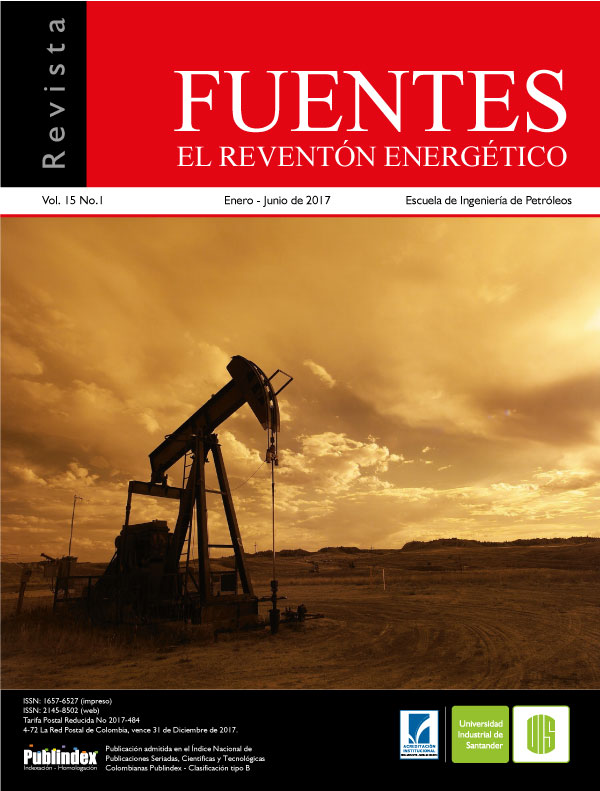Formation damage prediction due to accumulation of CaCO3 during constant brine flow in porous media
Published 2017-06-01
How to Cite
Abstract
An experimental methodology was designed for recreate the CaCO3 continuous deposition in a porous media, displacing synthetic brines made of a typical composition of Colombian Field’s formation water, in known permeability Berea Plugs at different temperatures and different flow rates. The factorial experimental design used allowed to correlate thermodynamic parameters (represented by concentration of Ca++ and temperature) and hydrodynamic (represented by injection rate) during the entire displacement tests of brine in rock, in which the permeability reduction was thoroughly monitored, reaching values up to 90%. The proposed correlation in this study was developed with the aid of statistic software, which allows predicting the permeability reduction percentage due to CaCO3 scales, with an 85% data adjustment. This correlation was validated through another set of experimental tests, using several flow rates (1-3 cm3 / min), several temperatures (150-250 F) and different concentration of Ca++ ion in the synthetic brines (250-750 ppm).
Keywords: Formation Damage, Flow Assurance, Accumulation, Porous Media, CaCO3, Correlation.
Downloads
References
- Achurry, D. y Martinez, R. (2013). Modelamiento de la depositación de escamas de carbonato de calcio en el wellbore. Tesis de Pregrado. Bucaramanga: Universidad Industrial de Santander. Facultad de ingenierías Fisicoquímicas. Escuela de Ingeniería de Petróleos. 150 p.
- Caballero, F. y Rodriguez, J. (2015). Predicción de la tendencia incrustante por escamas inorgánicas ocasionadas por aguas de producción en los campos de EQUION y HOCOL. Tesis de Pregrado. Bucaramanga: Universidad Industrial de Santander. Facultad de ingenierías Fisicoquímicas. Escuela de Ingeniería de Petróleos. 120p.
- Carreño, J. y Rodriguez, J. (2016). Evaluación del daño de formación por efecto de la depositación de carbonato de calcio en el medio poroso. Tesis de Pregrado. Bucaramanga: Universidad Industrial de Santander. Facultad de ingenierías Fisicoquímicas. Escuela de Ingeniería de Petróleos. 72 p.
- Civan, F. (1996) AMulti-Purpose Formation Damage Model. SPE paper No. 31101. SPE FormationDamage Control Symposium, 14-15 February, Lafayette, Loisiana.
- Civan, F. (2007). Reservoir Formation Damage, Fundamentals, Modelling, Assesment, and Mitigation. Segunda Edición. Gulf Professional Publishing. University of Oklahoma.
- Crabtree, M., Eslinger, D., Fletcher, P., Miller, M., Johnson, A. y King, G. (2002). La lucha contra las incrustaciones-Remoción y prevención. Oilfield Review, Slumberger. p. 30 – 49.
- Dyer, S. y Graham, G. (2002). The effect of temperature and pressure on oilfield scale formation. Journal of Petroleum Science and Engineering. UK. p. 95-107.
- Fadairo, A., Omole, O. y Falode, O. Effect of Oilfield Scale Deposition on Mobility Ratio. SPE paper No. 114488. CIPC/SPE Gas Technology Symposium. 16-19 June. Calgary, Alberta. 2008.
- Gloede, M. y Melin, T. (2007). A new theorical approach to the calcium carbonate crystallisation process out of aquatic solution and the effect of impurities on it. NACE paper No. 07054. NACE Corrosion Conference & Expo. Houston, Texas.
- Marin, J. (2015). Determinación de la tendencia incrustante en las aguas de producción de los campos de Ecopetrol de acuerdo con sus condiciones operacionales de temperatura, presión y composición Tesis de Pregrado. Bucaramanga: Universidad Industrial de Santander. Facultad de ingenierías Fisicoquímicas. Escuela de Ingeniería de Petróleos. 108 p.
- Mateus, N. y Pacheco, J. (2015). Determinación del umbral de depositación de Carbonato de calcio en el medio poroso de un campo colombiano. Tesis de Pregrado. Bucaramanga: Universidad Industrial de Santander. Facultad de ingenierías Fisicoquímicas. Escuela de Ingeniería de Petróleos. 71 p.
- Moghadasi, J., Jamiala, M., Müller-Steinhagen., H, Sharif, A., Ghalambor, A., Izadpanah, M. y Motaie, E. (2003). Scale Formation in Iranian Oil Reservoir and Production Equipment During Water Injection. SPE paper No. 80406. SPE 5th International Oilfield Scale Symposium and Exhibition, 29-30 January. Aberdeen, UK.
- Muñoz, F. y Sandoval Y. (2008). Generalidades de la formación, prevención y tratamiento de depósitos de escamas. Revista Fuentes. vol. 6, No. 1, p, 37-46.
- Restrepo, A., Duarte, J. y Sanchez, Y. (2007). A Multiparameter Methodology for Skin Factor Characterization: Applying Basic Statistics to Formation Damage Theory. SPE paper No. 107674. ESP European Formation Damage Conference. 30 May-1June. Scheveningen, Netherlands.
- Seagraves, S. y Wu, Y. (1996). Comparison of scale index calculations and two predictive models. NACE paper No. 186. CORROSION 96. Houston, Texas.
- Stamatakis, E., Stubos, A. y Muller, J. (2011). Scale prediction in liquid flow through porous media: A geochemical model for the simulation of CaCO3 deposition at the near-well region. Journal of Geochemical Exploration. JGE paper No. 108. 115-125 p.
- Tahmasebi, H. y Kharrat, R. (2007). Prediction of Permeability Reduction Rate Due to Calcium Sulfate Scale Formation in Porous Media. SPE paper No. 105105. SPE 15th Middle East Oil & Gas Show and Conference. 11-14 March. Bahrain, Kingdom Bahrain.
- Zhang, Y. y Farquhar, R. (2003). Laboratory Determination of Calcium Carbonate Scaling Rates for Oilfield Wellbore Environments.
- SPE paper No. 68329. SPE International Symposium on Oilfield Scale, 30-31 January. Aberdeen, UK. 2001. Aberdeen, UK.
